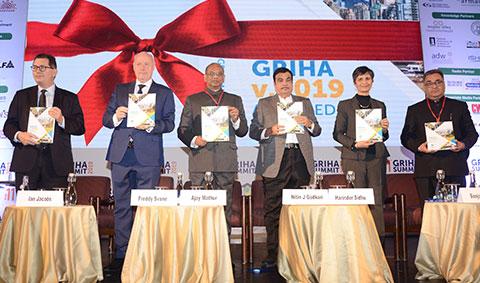Converting waste into wealth is the new vision for India: Nitin Gadkari

Focusing on 'Integrated Approach to Sustainability', the 11th GRIHA Summit deliberates on challenges of urbanization, energy, waste and water.
New Delhi, December 17: Highlighting that nearly 65% of India's population is rural, Nitin Gadkari, Union Minister for Road Transport & Highways and MSMEs, said that creating employment for the rural, agriculture and tribal sector is a high priority for the government. This requires knowledge, technology and innovation that can drive sustainable development in India, he added.
The Minister was speaking at the 11th edition of the GRIHA Summit, co-hosted by GRIHA Council and UNSW, Sydney, at the India Habitat Centre in New Delhi. The theme for this year's Summit is "Approach to Integrated Sustainability".
Speaking about various green initiatives of the government, Gadkari said, "Creating waste into wealth is the new vision for the country. We are working hard to formulate a policy on biofuels in the transport sector. We are also promoting ethanol and bio-compressed natural gas (bio-CNG). The sector is growing very fast. There are plans to make bio-CNG from rice husk in Delhi. We have also launched India's first motorbike powered on 100% bioethanol."
Citing the example of Nagpur, the Minister said the city earns nearly Rs 300 crore from recycling sewage water and nearly 80 buses in the city are plying on bio-CNG, made from sludge and various kinds of biowaste. He also spoke about the use of flyash waste being used in construction and the mandatory use of 8% plastic in road construction. In Maharashtra, the Minister spoke about the rejuvenation of rivers and nullahs in a few districts, by deepening the water bodies and using the material for making aggregate used in road construction.
The 11th GRIHA Summit also released a new version of the GRIHA rating - Version 2019. GRIHA (Green Rating for Integrated Habitat Assessment) is India's National Rating System for green buildings. It measures the environmental performance of a building based on a set of criteria. Developed in keeping with the on-going advancements in the Indian construction sector, GRIHA v.2019 has technical revisions with an introduction to Life Cycle Costing and Life Cycle Assessment and Water Performance Index (WPI) concepts. Through the integration of user experience, market feedback, and ease of implementation, GRIHA v.2019 aims to push the market towards enhanced resource efficiency and to incrementally increase the green building footprint across India.
Her Excellency Harinder Sidhu, Australian High Commissioner to India, said India and Australia face similar challenges of urbanization, which get further complicated by climate change. Talking about the need to make homes and cities liveable and functional, she said, "We commend the GRIHA Council for making frameworks that reduce emissions from our built environment."
His Excellency Freddy Svane, Ambassador, Royal Danish Embassy to India, emphasised Denmark's commitment to reduce 70% emissions by 2030, through their own efforts and not by any carbon trading mechanism. Talking about India's efforts, he added, "The social aspect of sustainability is important. Billions of people in India should be able to enjoy the same quality of life as developed countries, but with more responsibility and with the help of technology and innovation." He also talked about developing a strategic partnership between India and Denmark.
During the inaugural session, several new projects across India that have demonstrated compliance under the GRIHA rating system received awards. ITC Kohenur in Hyderabad, "Integrity" Campus at Titan Corporate Office in Bengaluru, National Academy of Customs, Indirect Taxes and Narcotics (NACIN) in Hyderabad, Indian Institute of Management (IIM) Kozhikode Campus (Phase V), and Bihar Museum in Patna are among the recipients of a 5-star GRIHA rating. The rating variant GRIHA is designed for new constructions having built-up area more than 2500 square metres. The rating system consists of 31 criteria categorized under various sections such as Site Planning, Construction Management, Occupant Comfort and Wellbeing, Sustainable Building Materials, Performance Monitoring and Validation, and Innovation.
Among other award recipients were Sukoon project in Indore for Simple Versatile Affordable GRIHA (SVAGRIHA) rating, Dalmia Vidya Mandir in Rajgangpur, Odisha for GRIHA for Existing Day Schools rating, and AHP Project, Smart Ghar-3 in Rajkot for GRIHA for Affordable Housing rating that is aligned to the Pradhan Mantri Awas Yojana.
Speaking at the Summit, Dr Ajay Mathur, Director General, TERI said, "Of all the buildings made in 2019 in India, 5% are GRIHA rated. This was only 2%, 3 years ago. This growth creates an environment where more people are encouraged to adopt green buildings." He added that this has happened in Maharashtra where a large number of government agencies have taken up the GRIHA code.
Professor Ian Jacobs, President and Vice Chancellor, UNSW, Sydney, spoke about his institute's forty years of knowledge and expertise in the field of built habitats and expressed pride in being an important partner of the GRIHA Council and the GRIHA Summit. "This collaboration will produce practical solutions for 21st-century living", he added.
During the two-day flagship event, various discussions will take place on five grand challenges of urbanization, energy, waste, water, and governance. Simultaneously, 12 thematic tracks intend to bring forth ideas on Reducing the Global Carbon Footprint, Women in Sustainability, Changing Consumer Behaviour, Air Pollution, and Social Aspect of Sustainability. Along the lines of the 11th GRIHA Summit, the GRIHA Council has set up an exhibition at Charminar, India Habitat Centre, to display a range of environmentally sustainable products and technologies.
About GRIHA Council
GRIHA (Green Rating for Integrated Habitat Assessment): the National rating system for green buildings in India, is a design cum evaluation tool for green buildings and habitats. It is a rating tool which evaluates the environmental performance of a building holistically over its entire life cycle, based on quantitative and qualitative criteria. GRIHA rating has been formulated and further being developed by GRIHA Council, which is an independent not-for-profit society established by The Energy Research Institute (TERI) and Ministry of New and Renewable Energy (MNRE), Government of India.
For further information, contact:
GRIHA Council - Santhosh Ramkumar: santhosh.ramkumar@grihaindia.org
Edelman - Rakhi Aurora: rakhi.aurora@edelman.com

